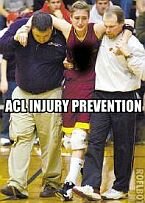Ankle Sprains
"I sprained my ankle." "I twisted my ankle." "I rolled my ankle." "He's got a high ankle sprain." Many terms are thrown about to describe ankle sprains. There are different types of sprains and different degrees of sprains. First, here are some definitions:
- A sprain is an injury to a ligament. A ligament attaches bone to bone (tendons attach muscle to bone).
- When a ligament is strained it means that the fibers of the ligament have torn.
- There are three grades of sprain:
- Grade I: mild to moderate pain and mild to moderate loss of function (range of motion and strength).
- Grade II: moderate pain and moderate loss of function.
- Grade III: severe pain and complete or almost complete loss of function.
Now let's understand some anatomy. The two bones of the leg are called the shin or tibia (inside bone) and fibula (outside bone). The two bones end at the ankle joint. The two bones are joined by ligaments to the ankle bones called the talus and calcaneus (heel bone). The inside bump on the ankle is called the medial malleolus (end of the tibia) and the outside bump on the ankle is called the lateral malleolus (end of the fibula). It is at these junction areas that ankle sprains typically occur.
The most common type of sprain occurs when the ankle is rolled inward. Damage is done to the ligaments that run on the outside of the ankle (lateral malleolus to the talus and calcaneus). This type of sprain is called an inversion sprain. Less common is a sprain that occurs when the ankle is rolled outward. This type of movement causes damage to the ligaments that run on the inside of the ankle (medial malleolus to the talus and calcaneus). These ligaments are much tougher and thicker than the ligaments on the outside of the ankle, so they need a much greater force to cause an injury. This type of sprain is called an eversion sprain.
Many of you have probably heard the term "high ankle sprain." This injury is becoming more and more prevalent in professional sports (football, basketball, soccer). The ligaments and tissues between the tibia and fibula (interosseous membrane) are damaged in this type of sprain. This is a much more serious injury than the above two sprains. Frequently, surgery must be done to repair the injury as in Terrell Owen's case. He had 3 injuries: he sprained the interosseous membrane, he sprained the ligaments on the inside of the ankle and he fractured his fibula.
Proper diagnosis of these sprains is critical to proper treatment. Initial treatment must include RICE: rest, ice, compression and elevation. Cessation of activity must occur. Frequently, some type of brace (like an Aircast) is needed for support and compression. Crutches may be necessary for several days. Hands on treatment should begin as soon as possible to remove the fluid from the area and break up the scar tissue that forms (Active Release Technique and Graston Technique). Fluid that just "sits around" is the worst thing for proper healing. Restoration of range of motion should begin as soon as possible. Spelling the alphabet with your foot is a great way to start. Next is restoration of strength by turning the ankle in and out against resistance (like exercise tubing or bands).
Finally, balance training MUST be done before return to sport. One of the things that occur with this type of injury is a loss of what is called proprioception or joint position sense. An example of proprioception is the ability to walk on uneven terrain. You don't have to tell yourself, "foot- move up, move down, move in, move out" when walking or running on uneven ground because the connection from the brain to the muscles and back is not damaged. When you sprain your ankle, this ability does become hampered. That's the bad news. The good news is that it can be retrained. Just practicing standing on one foot is a good way to start.
See Active Release Techniques® and Graston Technique for more information on injury care and prevention.
|
The Ultimate Nutritional Lie Detector Test LEARN MORE 
|
Kettlebell Rehab

Click Here
To See How Kettlebells will transform your body!
Vortex Rehab

Click Here
To See How This
Revolutionary Machine
Can Help You!
Partner / Support

Loans up to 3 months - fast cash advances for up to 90 days and up to $5,000!


















